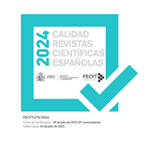Feminine morphology in possessive complements of adverbial constructions in Andalusian varieties
Resumen
El presente estudio indaga la variación morfológica entre los complementos posesivos masculinos y femeninos que se usan con adverbios locativos (p.ej., cerca mío / mía). El sufijo femenino con -a (p.ej., mía) constituye una variante innovadora que las gramáticas normativas califican de una variante estigmatizada de baja frecuencia. Este artículo se centra en el español de Andalucía donde se han documentado los usos más elevados de la variante innovadora. Se recopilan datos de Twitter de las ocho capitales andaluzas para precisar la distribución diatópica de la innovación así como su difusión en diferentes contextos lingüísticos. Los resultados cuantitativos demuestran que la variante femenina con -a predomina en toda Andalucía y que se ha completado el cambio en todos los contextos adverbiales locativos. Proponemos que se ha producido una serie de extensiones analógicas a través de la que el complemento posesivo femenino se va difundiendo de un contexto adverbial a otro, engendrando así un efecto analógico de bola de nieve.
Descargas
Descarga artículo
Licencia
La revista Círculo de Lingüística Aplicada a la Comunicación, para fomentar el intercambio global del conocimiento, facilita el acceso sin restricciones a sus contenidos desde el momento de su publicación en la presente edición electrónica, y por eso es una revista de acceso abierto. Los originales publicados en esta revista son propiedad de la Universidad Complutense de Madrid y es obligatorio citar su procedencia en cualquier reproducción total o parcial. Todos los contenidos se distribuyen bajo una licencia de uso y distribución Creative Commons Reconocimiento 4.0 (CC BY 4.0). Esta circunstancia ha de hacerse constar expresamente de esta forma cuando sea necesario. Puede consultar la versión informativa y el texto legal de la licencia.











